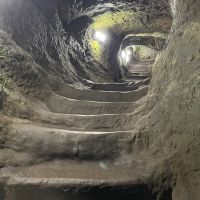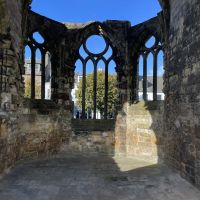25/09/24
A work interlude
We passed a couple of days in peace and quiet at Drumcarro Farm campsite, a small inland CL with a friendly owner, EHU and excellent 4G reception to allow me to work. We were the only people there, which was good for us, less so for Hugh, the owner. He said he’d had a busy summer though.
While there we didn’t get out and about much, but did manage a couple of short walks up to the local crag where a pile of stones needed a lot of imagination to be considered the remains of a broch. Between the clouds we got good views out to St Andrews and the Tay.
Parking at Kingsbarns
Once finished with work we moved on to Kingsbarns beach parking. This was another of the Fife Coast and Countryside Trust parking areas. Beachside, with several motorhome spaces. It was very quiet on the mid week, just a Dutch van there when we arrived and another small van arrived the next day. There is a permanent van on site, lived in by a volunteer warden. I’m not sure how formal the arrangement is, but he came and went without bothering us.

Bertie at Kingsbarns
On the way down we noticed that the road was going to be closed the following week for the Golf Links Championship. Golf is serious business round here with links courses all along the coast. People were still playing, despite the autumn winds, including several groups with caddies. When we popped into the local pub later that day (for some warm soup and a pint) it was mostly occupied by groups of male friends, I assume they were mostly golfers.
The parking at Kingsbarns was lovely and peaceful until the wind picked up that night. The howling wind picked up sea spray and covered Bertie in a sand and salt coating which needed a good clean after we left.
Walking into St Andrews
Our morning arrival at Kingsbarns meant we had plenty of time to walk into St Andrews along the coast path. It was another lovely Fife coastal walk.
On the way to St Andrews the sandy path was undercut by the wind and sea, in places so eroded that there was no option but to drop down to the beach every now and again. Luckily we were walking at low tide which not only gave us a safe beach to walk on, but also exposed the interesting sandstone, shale and limestone rocks. A sign warned us that the path was too dangerous to continue but we couldn’t see the issue so made the decision to carry on. When we met two other walkers they asked how bad the path was, the last time they had attempted the walk they had needed to climb a farmer’s fence to get around the worst section and ended up abandoning their walk. It just shows how much of a difference the tide can make.
- Warning sign
- Rocky beach at low tide
- Interesting formations
Where Kenly Water meets the coast, the path meanders inland for a while. It provided a little variety. Ducks dabbled in the pool by the beach and the valley was wooded, with a few ruined buildings along the stream. Crossing a bridge took us to the village of Boarhills, where we sat on the green by the dovecote and drank our hot drinks.
- Where the Kenly Water meets the sea
- Dovecote in Boarhills
From there we made our way past farms and down to the coast where Buddo rock was an impressively eroded feature. The sandstone arch has one leg that we thought looks a little like a doner kebab. We climbed a channel through the rock to get close to the top, but the pigeons had left a lot of slimy bird poo so it wasn’t a place we wanted to linger.
- Buddo Rock
- Paul at the top of the rock
- Slimy channel through Buddo Rock
After Buddo rock, the path rose and dipped as the landscape changed from flat and sandy to rocky cliffs. The Rock and Spindle were another interesting feature, this time the basalt remains of a volcanic intrusion.
- The Rock and Spindle
- Paul gave this a different name
Finally we could start to see St Andrews in the distance, an attractive collection of spires and towers that slowly got closer as we finished the coast walking part of the day.
- St Andrews
- Getting Closer
- Almost there
Exploring St Andrews
Our first port of call in St Andrews was The Cheesy Toast Shack. Paul had been put in charge of researching food options and he had identified this as an ideal lunch stop. His research had been spot on, a couple of very tasty pimped up cheese toasties which warmed filled us after our walk. They offer insurance here; pay an extra £2 and they will provide you with a second toastie for free if your first one gets snaffled by a seagull. Luckily Paul and I are seaside residents and know how to protect our food (although we have definitely been guilty of taking our eye off the ball on occasion).
- Scrummy Cheese Toasty
- And Ice Cream
The queue at the toast shack gave us a first taste of the local student population as a group of young people waiting with us started talking about the supercars owned by their parents and friends. “I told him not to buy his girlfriend that Maserati” said one of them. There is money here!
The other people here, of course, were tourists. The most foreign visitors we’d seen since Edinburgh. Along with the rest of the tourists we wandered up to the cathedral and explored amongst the ruins and the Heras fencing (there to protect us against rogue gravestones and falling masonry). The cathedral was ransacked in 1559 following a sermon by protestant reformer John Knox and fell into ruin, eventually being dismantled to provide dressed stone for the construction of other local buildings. I had always assumed that St Andrews cathedral had been re-appropriated by the protestant church, like most of the English cathedrals, and had no idea that it was a ruin.
From the cathedral we moved onto the castle. This was another building associated with the church, constructed by one of the early bishops of St Andrews as their official residence. Just like the cathedral it was a victim of the reformation, and once the catholic bishops were no longer part of the Scottish establishment the castle fell into disuse. It was also a victim of the sea, with much of the great hall being lost in a cliff fall in the 1800s.
The best bit about the castle is the ability to descend into the mines beneath the castle walls, not the coal or gold type of mine. The first mine was dug through solid rock by besiegers of the castle during an altercation related to the reformation. The protestant occupiers of the castle then dug a counter mine. They started several holes before the successful counter-mine was dug, meeting up with the mine and repelling the invaders. The amount of effort that must have gone into chiselling these tunnels through the rock is incredible, and the fact that you can still descend them as a visitor is quite remarkable.
We finished our visit to St Andrews with an ice-cream and a wander round the streets and university buildings before catching a bus back to Kingsbarns.
































